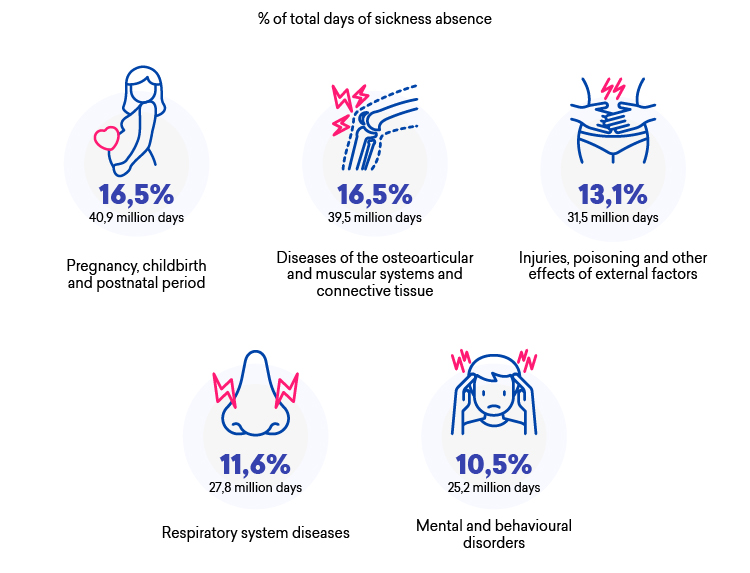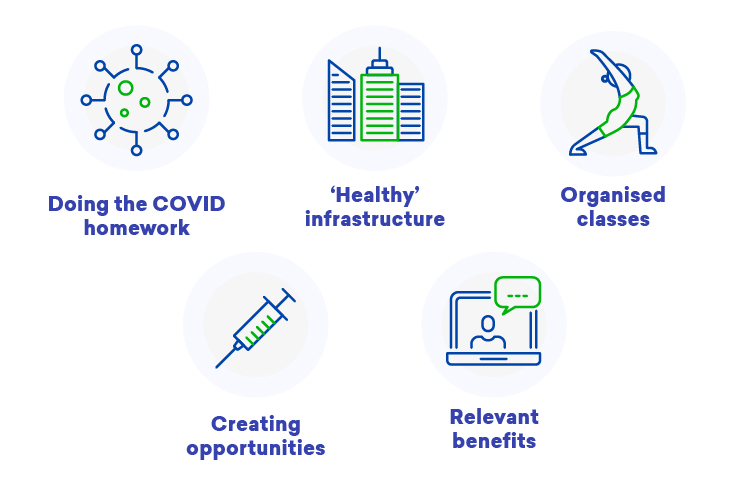In this article you will learn:
- Why is caring for the health of your employees important to your organisation?
- What are the costs of high absenteeism?
- What solutions do modern companies practice in the field of health promotion?
- How and why can you avoid presenteeism?
Useful definition: The Central Institute for Labour Protection indicates that absence can be understood as lost working time, but in this article we focus only on sickness absence due to own illness, and not, for example, caring for a sick person[1].
Health – a key investment
Modern companies make every effort to provide employees with the right conditions, but also give them tools to facilitate health care, e.g. medical packages and services. Why is it so important? In other words, what does a healthy employee give the company and how does the company lose out on employee illness?
- Profits
Time is money. There is no doubt about that, especially when we take into account the time of employee absences. As it turns out, 1% of sickness absence corresponds to a loss of 0.7% of the company’s profit[3].
- Costs
Loss of profits is one thing, but costs are also important – not only the official ones, directly related to a given employee, but also the costs of substitution (including recruitment and training of a new person), possible overtime or administrative services[1]. As a result, caring for the health of employees brings economic benefits in the form of cost reduction, which ranges from a few to 70%[6].
- Image
Taking care of the well-being of employees means not only less absenteeism, but also a better image among job candidates[3]. Professionals will be more likely to choose a company that cares for its employees, and current employees will feel more safe and “cared for”.
- Effectiveness
Even a simple runny nose, which some of us do not even treat as a disease, reduces productivity by 20%[4]. No wonder – health really affects the speed and quality of work. You should also remember that mistakes made by distracted, sick employees can be not only expensive, but also dangerous.
- Atmosphere
Health affects the quality of communication between employees[7]. Even a minor cold can mean that the employee will come to work feeling irritable, and negative emotions will affect the whole team. Overtime and the need to frequently substitute for absent persons also have a negative impact on the working atmosphere.
Can a company prevent absenteeism?
Absolutely. In 2012, Eurostat conducted a study which showed that approximately 26% of the total absence of employees results from work-related diseases[6]. Of course, nowadays, these results have been shaken by the pandemic, and then the subsequent wave of mental health problems among employees. However, it must be admitted that despite the decades that have passed, many companies have still not learned the lesson of creating a safe and healthy work environment, which in itself is the key to reducing sickness absence. Meanwhile, properly selected activities can reduce the company’s expenses caused by absence by a few up to even 70%[3].
But OHS is not everything. The work culture itself is also important. It turns out that up to 70% of leaves with the indication “the patient can walk” or given to take care for a family member are used as an escape from work. It is estimated that such practice accounts for as much as 10% of sickness absence on average[3].
It is clear that different types of absences are generated by completely different factors. Therefore, the first step in counteracting it should be to verify which area it belongs to. Most often, the following three are distinguished:
- natural – the employee actually gets sick;
- shadow – the employee is not sick, but prolongs the actual leave, avoids returning to work (‘easy’ access to sick leaves, lack of motivation to work, etc.);
- professional – the employee uses the leave to receive benefits without appearing at work[7].
In particular, we are interested in the first type – it is possible to lower its rate by introducing hygiene and work culture changes that will be universal to a great extent.
In the case of shadow and professional absenteeism, individual company-specific factors are often involved, including quality of management or poorly designed indicators and processes[3].
Note: minimising absences should be treated as a systemic action. It is necessary to start by identifying the real causes and type of absence, and then developing an absence policy that will cover a whole group of actions and solutions.
Minimal natural absenteeism – how to take care of the employees’ health?
According to the latest available Social Insurance Institution (ZUS) report, in 2021, the causes of sickness absence of Polish employees were as follows:

So you can see at first glance that appropriate, systemic actions can reduce the level of sickness absence, because a large part of the diseases is related to health and safety issues. So, for example, diseases of the osteoarticular or muscular systems can be correlated with properly prepared workstations, while care for the respiratory system of employees includes, among others, proper air conditioning and properly ventilated rooms.
What is important, all the above diseases are also greatly influenced by an appropriate lifestyle. And here we come to the point – prevention is better than cure. But how to ensure proper prevention for your team?
Solutions to support preventive health care

- Doing the COVID homework – the pandemic has taught us that solutions such as the right distance between employees, hand sanitizers and disinfection equipment, instructions for proper behaviour, proper ventilation of rooms have a positive impact on health – it is worth keeping them in mind today as well. Hybrid working – especially in periods of frequent illness – can also lead to less absenteeism.
- ‘Healthy’ infrastructure – in addition to ergonomic workstations and adequate lighting, is also worth creating a space that supports a healthy lifestyle. In the case of large companies, these can be separate gyms, changing rooms and showers for cyclists or relaxation rooms that allow the employees to rest after stressful meetings.
- Organised classes – from corporate yoga, to webinars devoted to health, to the possibility of using massage or consulting an expert, e.g. a physiotherapist – today the number of solutions of this type is virtually unlimited.
- Creating opportunities – in the abundance of duties, it is easy to forget about regular tests, so it is worth introducing company events, e.g. days dedicated to a specific disease or introducing elements of gamification to motivate people to move more.
- Relevant benefits – nowadays, a gym membership card or medical care is just the beginning. For example, it is worth giving your employees the ability to take advantage of teleconsultation with specialists or access to important preventive examinations.
Of course, the best results come from the synergy of solutions – for example, by creating an Allergy Awareness Day, we can combine benefits (e.g. a respiratory or food allergic package available at MultiLife) with a relevant webinar and gamification (e.g. a quiz for employees).
We already know what you CAN do, but what actions can actually harm your business?
To a large extent, those that result from… exaggerated fight against sickness absence. The so-called presenteeism – i.e. the tendency of employees to come to work despite being ill – can cause the entire department to end up on a sick leave. In addition, according to the research of Dr. Małgorzata Pęciłło from the Central Institute for Labour Protection – National Research Institute, the costs of the presence of sick employees at work may significantly exceed the costs incurred by the employer due to their absence[9]. Therefore, it is worth taking care of the appropriate corporate culture and the type of agreements that will prevent this tendency.
By creating a healthy and friendly working environment and giving your employees tools and opportunities for prevention and treatment, you can reduce such risks. As a result, you will be able to create an effective organisation that generates profits and at the same time is friendly to its employees.
Sources:
1. https://wskaznikihr.pl/biblioteka/absencja_chorobowa_w_polsce_644d617f.
2. https://wskaznikihr.pl/biblioteka/jak_radzic_sobie_z_absencja_wsrod_pracownikow__ac45ae20.
3. https://www.pulshr.pl/rynek-zdrowia/jak-ograniczyc-absencje-chorobowa-pracownikow-oto-wskazowki,69152.html.
4. https://ipri.com.pl/blog/2020/10/19/prezenteizm-nieefektywna-obecnosc-w-pracy/.
5. https://zielonalinia.gov.pl/-/presenteeism-czyli-chory-w-pracy-28663.
6. https://www.ciop.pl/CIOPPortalWAR/appmanager/ciop/pl?_nfpb=true&_pageLabel=P30001831335539182278&html_tresc_root_id=300001810&html_tresc_id=300001824&html_klucz=19558&html_klucz_spis=.
7. https://www.magazynrekruter.pl/absencja-chorobowa-kiedy-staje-sie-problemem/.
8. https://www.zus.pl/documents/10182/39590/Absencja+chorobowa_raport_2021.pdf/8ca8025c-f6dc-b02c-a7e4-5aa99d28af9a?t=1652869131280.
9. https://www.ciop.pl/CIOPPortalWAR/appmanager/ciop/pl?_nfpb=true&_pageLabel=P30001831335539182278&html_tresc_root_id=300001810&html_tresc_id=300003928&html_klucz=19558&html_klucz_spis=.
